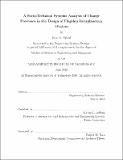| dc.contributor.advisor | Olivier L. deWeck. | en_US |
| dc.contributor.author | Ward, Eric D. (Eric Daniel) | en_US |
| dc.contributor.other | Massachusetts Institute of Technology. Engineering Systems Division. | en_US |
| dc.date.accessioned | 2017-03-10T14:20:03Z | |
| dc.date.available | 2017-03-10T14:20:03Z | |
| dc.date.copyright | 2016 | en_US |
| dc.date.issued | 2016 | en_US |
| dc.identifier.uri | http://hdl.handle.net/1721.1/107291 | |
| dc.description | Thesis: S.M. in Engineering and Management, Massachusetts Institute of Technology, School of Engineering, System Design and Management Program, Engineering and Management Program, 2016. | en_US |
| dc.description | This electronic version was submitted by the student author. The certified thesis is available in the Institute Archives and Special Collections. | en_US |
| dc.description | Cataloged from student-submitted PDF version of thesis. | en_US |
| dc.description | Includes bibliographical references (pages 99-100). | en_US |
| dc.description.abstract | In the engineering of complex systems, changes to flight hardware or software after initial release can have large impacts on project implementation. Even a comparatively small change on an assembly or subsystem can cascade into a significant amount of rework if it propagates through the system. This can happen when a change affects the interfaces with another subsystem, or if it alters the emergent behavior of the system in a significant way, and is especially critical when subsequent work has already been performed utilizing the initial version. These changes can be driven by new or modified requirements leading to changes in scope, design deficiencies discovered during analysis or test, failures during test, and other such mechanisms. In complex system development, changes are managed through engineering change requests (ECRs) that are communicated to affected elements. While the tracking of changes is critical for the ongoing engineering of a complex project, the ECRs can also reveal trends on the system level that could assist with the management of current and future projects. In an effort to identify systematic trends, this research has analyzed ECRs from two different JPL led space mission projects to classify the change activity and assess change propagation. It employs time analysis of ECR initiation throughout the lifecycle, correlates ECR generators with ECR absorbers, and considers the distribution of ECRs across subsystems. The analyzed projects are the planetary rover mission, Mars Science Laboratory (MSL), and the Earth-orbiting mission, Soil Moisture Active Passive (SMAP). This analysis has shown that there is some consistency across these projects with regard to which subsystems generate or absorb change. The relationship of the ECRSubsystem networks identifies subsystems that are absorbers of change and others that are generators of change. For the flight systems, the strongest absorbers of change were found to be avionics and the mechanical structure for the spacecraft bus, and the strongest generators of change were concentrated in the payloads. When this attribute is recognized, project management can attempt to close ECR networks by looking for ways to leverage absorbers and avoid multipliers. Alternatively, in cases where changes to a subsystem are undesirable, knowing whether it is an absorber can greatly assist with expectations and planning. This analysis identified some significant differences between the two projects as well. While SMAP followed a relatively well behaved blossom profile across the project, MSL had an avalanche of change leading to the drastic action of re-baselining the launch date. While the official reasoning for the slip of the launch date is based in technical difficulties, the avalanche profile implies that a snowballing of change may have had a significant impact as well. Furthermore, the complexity metrics applied show that MSL has a more complex nature than SMAP, with 269 ECRs in 65 Parent-Child clusters, opposed to 166 in 53 for SMAP, respectively. The Process Complexity metric confirms this, quantitatively measuring the complexity of MSL at 492, compared to 367 for SMAP. These tools and metrics confirm the intuition that MSL, as a planetary rover, is a more complex space mission than SMAP, an earth orbiter. | en_US |
| dc.description.statementofresponsibility | by Eric D. Ward. | en_US |
| dc.format.extent | 107 pages | en_US |
| dc.language.iso | eng | en_US |
| dc.publisher | Massachusetts Institute of Technology | en_US |
| dc.rights | MIT theses are protected by copyright. They may be viewed, downloaded, or printed from this source but further reproduction or distribution in any format is prohibited without written permission. | en_US |
| dc.rights.uri | http://dspace.mit.edu/handle/1721.1/7582 | en_US |
| dc.subject | Engineering and Management Program. | en_US |
| dc.subject | System Design and Management Program. | en_US |
| dc.subject | Engineering Systems Division. | en_US |
| dc.title | A socio-technical systems analysis of change processes in the design of flagship interplanetary missions | en_US |
| dc.type | Thesis | en_US |
| dc.description.degree | S.M. in Engineering and Management | en_US |
| dc.contributor.department | Massachusetts Institute of Technology. Engineering and Management Program | en_US |
| dc.contributor.department | System Design and Management Program. | en_US |
| dc.identifier.oclc | 973332372 | en_US |
